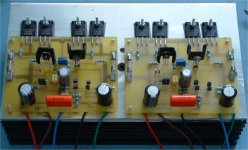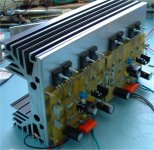Nice work! 
I just want to comment your drivers. This arrangement is very sensitive to vibrations and chocks (not a problem in your case maybe, the amp will be at home and not moved around). Shorten the transistor pins and fixate the heatsinks with glue. Copper pins are rather weak when it comes to bendning back and forth.

I just want to comment your drivers. This arrangement is very sensitive to vibrations and chocks (not a problem in your case maybe, the amp will be at home and not moved around). Shorten the transistor pins and fixate the heatsinks with glue. Copper pins are rather weak when it comes to bendning back and forth.
Hey Matth,
Your homepage doesn't work!🙁
Nice layout!
But I think you can save some free spaces in the board..
Your homepage doesn't work!🙁
Nice layout!
But I think you can save some free spaces in the board..
Thanks for the comments guys.
Peranders, the amps will be in the horizontal position and the heatsinks are not very heavy so I think it won't be a problem, but point taken.
AudioPT, Yeah I see now that I have left "pwp" out of my URL, don't worry though your not missing anything at the moment, I just use the space to host pictures. I must get around to cleaning is up at some point.
I think this board could be condensed down to a very small size but at the moment it meets my requirements, feel free to modify the layout and post it back.
I haven't lisened to these amps yet, I was doing final scope testing and power testing yesterday when I mistakenly connected the output of my function generaator to the +50v lead instead of the i/p lead a moment later the generator went bang
a moment later the generator went bang Doh!!
Doh!!
I will let you all know how it sounds after the weekend.
Peranders, the amps will be in the horizontal position and the heatsinks are not very heavy so I think it won't be a problem, but point taken.
AudioPT, Yeah I see now that I have left "pwp" out of my URL, don't worry though your not missing anything at the moment, I just use the space to host pictures. I must get around to cleaning is up at some point.
I think this board could be condensed down to a very small size but at the moment it meets my requirements, feel free to modify the layout and post it back.
I haven't lisened to these amps yet, I was doing final scope testing and power testing yesterday when I mistakenly connected the output of my function generaator to the +50v lead instead of the i/p lead
 a moment later the generator went bang
a moment later the generator went bang Doh!!
Doh!!I will let you all know how it sounds after the weekend.
In industrial environments heavy things on long leads is a bigmatth said:Thanks for the comments guys.
Peranders, the amps will be in the horizontal position and the heatsinks are not very heavy so I think it won't be a problem, but point taken.

"Heavy" is not very heavy in order to get you into trouble but as a genreal rule: keep big caps, heatsinks, transformers etc. tightened to the pcb with screws or glue.
An alternative view (about 180 degrees out):
If you have things that can move wrt each other, you NEED to have some lead length to prevent things from cracking and/or breaking.
Don't shorten the transistor leads, they are necessary to pick up any movement relative to the PCB when heating and cooling.
Jan Didden
If you have things that can move wrt each other, you NEED to have some lead length to prevent things from cracking and/or breaking.
Don't shorten the transistor leads, they are necessary to pick up any movement relative to the PCB when heating and cooling.
Jan Didden
Hello Jan,
I would agree with your post with respect to the output devices. However PerAnder was referring to the drivers that are up off the PCB by 2 cm or so. I agree with PerAnder in this regard.
Charles Hansen
I would agree with your post with respect to the output devices. However PerAnder was referring to the drivers that are up off the PCB by 2 cm or so. I agree with PerAnder in this regard.
Charles Hansen
As I said keep all radial parts pins short but axial parts like diodes, caps, resistors must have some "expanding room" especially if they are hot. Don't bend the legs too close to the body or with too small radius. Keep all parts close the pcb unless you have very special reasons for like very hot resistors which needs cooling.janneman said:Don't shorten the transistor leads, they are necessary to pick up any movement relative to the PCB when heating and cooling.
hy matth, I,ve see your work, good but in the Bill of Materials of standard LAT.bom there are some differences from original Antony Holton symmetrical amp;
can I have the schematics and the bill of materials of your work?
many tnx
Tino96
can I have the schematics and the bill of materials of your work?
many tnx
Tino96
Member
Joined 2002
Not bad..
question why such a big heat-sink.?
i've got Anthony's actual raw board layout via protel from him longtime ago and still have them on cd : O) i was thinking about actually building a stereo pair and see how they sound.
question why such a big heat-sink.?
i've got Anthony's actual raw board layout via protel from him longtime ago and still have them on cd : O) i was thinking about actually building a stereo pair and see how they sound.
i would have placed the transistors leads through the botton -- then you have only one 90degree bend.
- Status
- Not open for further replies.
- Home
- Amplifiers
- Solid State
- Holton Lateral Amp (Pic post)

